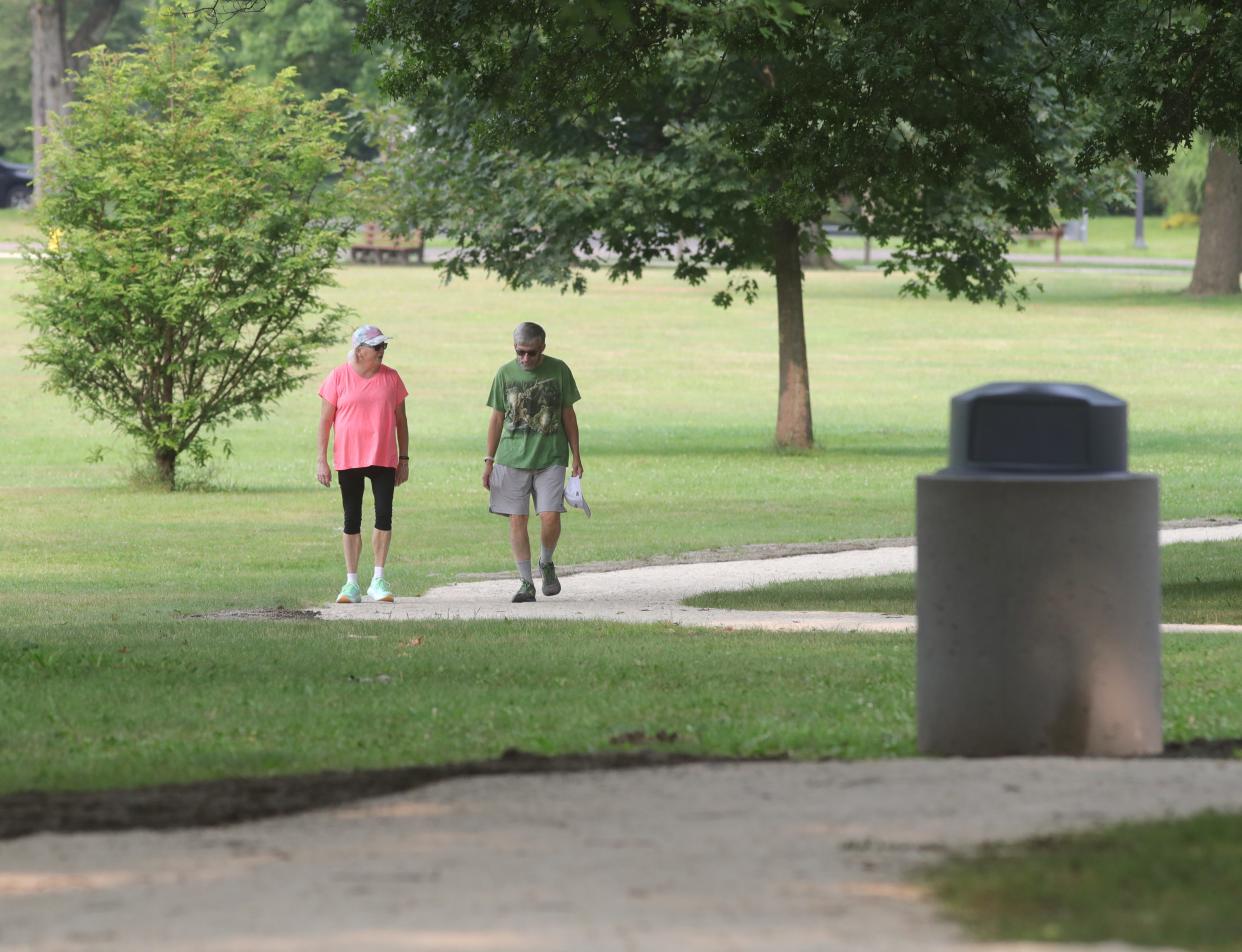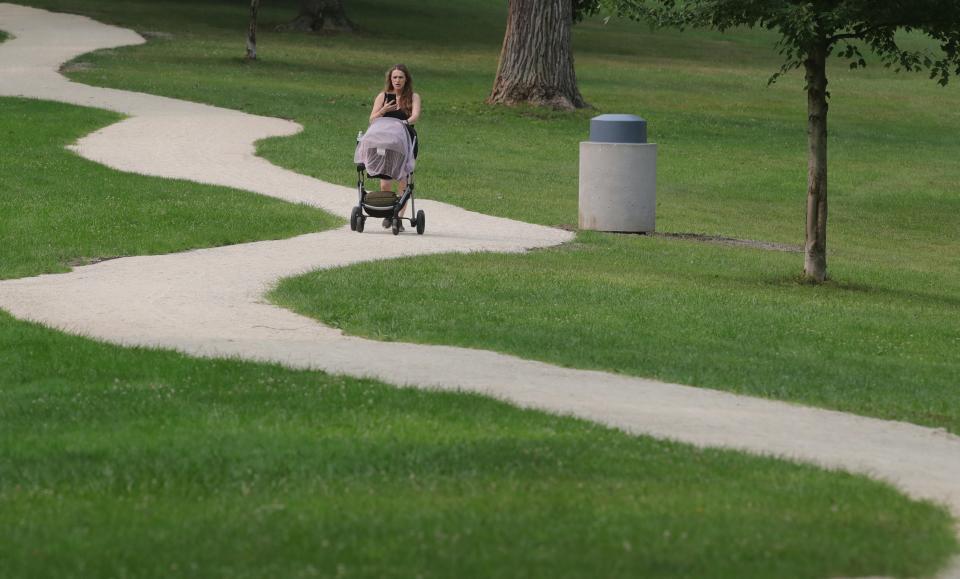A fine line: Schneider Park path balances safety, recreation with burial ground concerns

The construction of a walking trail hugging the perimeter of West Akron's Schneider Park has renewed curiosity about the site and the untold number of bodies buried beneath the inner park's surface.
The new path, which should be completed by the end of this week, is the culmination of years of talks between the city and neighbors who wish to maximize the park's potential uses. How the city allows the park to be used has long been guided by the property donor's stipulations and closely scrutinized by residents who want the unmarked graves to be treated as hallowed ground.
There is no playground equipment, nor are there any other permanent structures in the 15-acre Schneider Park, a section of which historians say served as a burial ground for the Summit County Infirmary between 1875 and 1919. Aside from occasional trees scattered throughout the landscape, it is an open expanse of green space that adapts to its users activities — whether walking dogs or conducting soccer or football drills.
The new path brings the most dramatic alteration to the park's appearance in decades, but neighbors say it is already improving safety and walkability. More enhancements are planned, with momentum also growing among residents seeking to memorialize those who were buried there long ago.
Finishing touches for Schneider Park walking trail
Stephanie Marsh, chief communications officer for the city of Akron, said crews are adding a final topcoat of crushed limestone to the new 0.77-mile walking trail, which she said has been long sought by neighbors.
"It's been brought up through our recreation department as well," Marsh said. "Ultimately, it came through planning and it was in our capital budget in 2022. It was designed by our engineering department and built by parks maintenance."
Many families with young children live near the park, which is bounded by Mineola, Crestview and Mull avenues and Thorndale, Sunset View and Schneider Park drives. But with few stretches of sidewalk nearby, people going to and from the park often have been forced to walk in the street.
That's been a big concern for the Rev. John Valencheck, pastor of St. Sebastian Parish. The Roman Catholic church and school are the park's biggest immediate neighbors.
"I know the community is excited about the walking trail; this has been something that residents have heard about for years, and we are grateful to the city for this addition to the park," Valencheck said. Even though some of the streets surrounding the park aren't particularly busy, he said, it's still important to get people out of the path of traffic — "especially some of the younger residents who frequent the park — and I'm glad the city recognized this need."
Marsh said installation of some other park amenities has begun, including trash cans and benches. Picnic tables also have been added.
"Whenever I visit the park, I am mainly walking around with my dog — but I've just noticed these new picnic tables, which is a nice feature for the area," Valencheck said.
Marsh said the city is asking visitors to refrain from parking on the park itself, as that may ruin the walking path.
"Some residents have gotten used to pulling onto the grass to park; there is no parking in the park," Marsh said. "Residents are encouraged to park on the street and walk into the park."
She said signs prohibiting parking on Schneider Park's surface have been posted, but it's still been an issue. She said enforcement will be stepped up soon.
"Cars will be ticketed if they continue parking in the park," Marsh said.

City works to honor park donor's wishes
Schneider Park was once a piece of a 230-acre farm that served as the Summit County Infirmary starting in the mid-1800s. It was used in part as a cemetery for the infirmary's destitute inhabitants, with unmarked graves left behind when the facility moved to Munroe Falls in 1916.
The land was sold to Philip Schneider, who developed houses in the area on all but the 15-acre swampland that would become the park. When Schneider died in 1935, he left the land to the city with the caveat that the property be "exclusively used for a public park" and prohibited the right to use it for baseball, Marsh said.
Akron Ward 4 Councilman Russ Neal emphasized that while some enhancements are being added to the site, the plan is to keep the park largely undeveloped as a recreational magnet.
"Families from all over come to use Schneider Park for recreational purposes, and the city has no plans to build a designated area for a particular sport; we will keep the park as is, which is an open space for a variety of activities," Neal said. "There is a challenge to find more recreational space in Akron, and our vision is to leave the park as is, as per the last wishes of Mr. Schneider when he transferred the land to the city."
Acknowledging Schneider Park's mystery-shrouded past
In recent years, exploration of the park's past has led to a push for a more formal recognition of its deeper history, Neal said. He said the walking trail was built with the dead in mind and intentionally keeps a distance from the burial area so that path users do not need to worry about walking over graves.
Conversations have begun "about potentially renaming the park to Schneider Memorial Park in order to honor the long-forgotten dead buried beneath the park, and those discussions are ongoing," he said.
Marsh acknowledged the discussions, adding that while the proposal will require coordination through the city, community-led efforts to establish special memorials have seen positive results.
"The recent Memorial Parkway commemoration was done through a private donation, so something like that would be a possibility in the future if funding was available."
Jane Greenland, a Crestview Avenue resident for 29 years, has led the Schneider Park renaming effort, gathering signatures from more than 20 neighbors so far. She said once she has enough signatures, she will turn them over to the city's Recreation and Parks division for eventual presentation to the Planning Commission.
"I wanted to keep the name of Schneider because he's the one who donated the property to the city of Akron," Greenland said. "The 'memorial' in the name pays homage to the people buried under the park; this should be considered a cemetery. I talked to (city arborist) Jon Malish and asked if I needed a minimum of signatures for the petition, and he said 'don't even worry about that,' so I'm hoping to turn in a good amount of signatures soon — and hopefully City Council can decide on a name change soon."
Greenland said community members are volunteering to take the petition into different neighborhoods to gather more signatures, and some University of Akron students may pitch in as well.
Greenland also hopes a plaque commemorating the dead can be constructed on the site; she has begun researching costs and creation, and said neighbors will likely chip in toward the project.
"I know that this is something that could happen," she said. "it just takes time and we have to be patient, but there needs to be something that lets visitors know that there are people buried underneath the park."
Reporter Anthony Thompson can be reached at ajthompson@gannett.com, or on Twitter, @athompsonABJ
This article originally appeared on Akron Beacon Journal: Schneider Park path walks fine line between recreation, burial site

